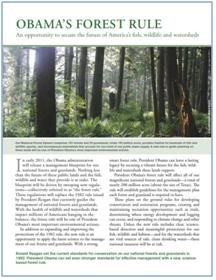This one from the Huffington Post
In its first sentence this article asserts that the point of the planning rule was to “take more control over the forests”; “hoping to break a legal logjam that has stymied logging”.
I would assert that that we are doing just fine, thank you, with the natural process of coevolution of litigation and agency response. I would argue that the reason for a new rule is:
That the case law around the 1982 rule has become obtuse and unworkable; that timber is no longer a big deal and should be treated as such; that a new rule should take into account the success of place- based collaboration and advisory committees; form a structure for adaptive management; and be cognizant that with the plethora of assessments (state assessments, vulnerability assessments, species assessments) that there is little that is going unassessed and that assessments have a shelf-life. I also agree with Andy that we have plenty of other layers of decisions now, such as oil and gas leasing decisions and travel management, that a forest plan no longer needs to be the comprehensive as it used to be. Monitoring and changing through a formal power-sharing arrangement with an advisory committee of some kind would be so much more 21st century.
As regular readers know, I am a biologist by education and most of my career, and so this quote was interesting:
“This flies in the face of the principal that has been in place, that the Forest Service’s job is to keep common species common,” said Rodger Schlickeisen, president of Defenders of Wildlife.
If a species is common, it is hard for me to imagine that any project that crosses my desk, or the sum of all these projects, could actually have an impact.
Forest Service Revising Rules In Bid For More Control
GRANTS PASS, Ore. — Hoping to break a legal logjam that has stymied logging as well as ecosystem restoration, the U.S. Forest Service said Thursday it was revising its planning rules to take more control over national forests and find more common ground between industry and conservation groups.
The old rules, dating back to the Reagan administration, designated certain animal species that must be protected to assure ecosystems are healthy. However, the system became the basis of numerous lawsuits that sharply cut back logging to protect habitat for fish and wildlife.
The new rules call for monitoring a broader range of species, including plants, while giving forest supervisors greater discretion to decide what science to apply and which species to protect, depending on local conditions.
Agriculture Secretary Tom Vilsack said from Washington, D.C., that it’s in everyone’s best interest to have forests that stay healthy amid climate change and economic demands.
“Rather than responding to the political pressure of the time, it would be much better to say to the scientists, ‘What is the best way to make this forest the most resilient it can be,'” Vilsack told The Associated Press.
The conservation group that forced the revision by persuading a federal judge to throw out the last one said the proposal represents a dangerous rollback of mandatory protections and gives too much discretion to forest supervisors.
“This flies in the face of the principal that has been in place, that the Forest Service’s job is to keep common species common,” said Rodger Schlickeisen, president of Defenders of Wildlife.
The 155 national forests and grasslands managed by the agency cover 193 million acres in 42 states and Puerto Rico. Balance between industry and conservation in those areas has been tough to find since the existing rules went into effect in 1982.
One revision of the rules by the Clinton administration and two by the Bush administration were thrown out by federal courts.
Here’s a piece from
Feds Propose Flexible Plans for Resilient Forests
Feds Propose Flexible Plans for Resilient Forests
With climate change posing new threats—more frequent forest fires, for example, and plagues of tree-killing beetles—the U.S. Forest Service is proposing to change the way it makes its management plans for national forests. The goal is to dramatically speed up the 5- to 8-year process, which is currently governed by a 1982 rule that officials describe as expensive and inefficient. The proposed draft, released yesterday, emphasizes the use of scientific evidence in creating management plans, as well as restoring forests so that they are resilient to pests and other stresses. “It’s very important that we get this [natural] system into a healthy state as quickly as possible,” says forest ecologist William Wallace Covington of Northern Arizona University in Flagstaff, who thinks the changes would be a positive step.
Not all environmental groups agree. Some do not like the latitude given to local supervisors of forests. But Covington says what’s important is allowing supervisors to take actions, such as thinning forests, that will make the overall habitat more healthy. The Forest Service is taking public comments for 90 days.





